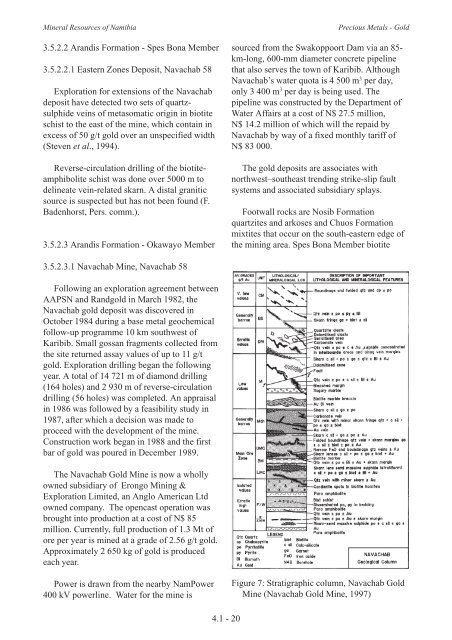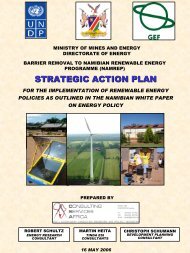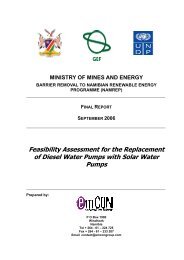Gold Chapter (855 KB) - Ministry of Mines and Energy
Gold Chapter (855 KB) - Ministry of Mines and Energy
Gold Chapter (855 KB) - Ministry of Mines and Energy
Create successful ePaper yourself
Turn your PDF publications into a flip-book with our unique Google optimized e-Paper software.
Mineral Resources <strong>of</strong> Namibia Precious Metals - <strong>Gold</strong><br />
3.5.2.2 Ar<strong>and</strong>is Formation - Spes Bona Member<br />
3.5.2.2.1 Eastern Zones Deposit, Navachab 58<br />
Exploration for extensions <strong>of</strong> the Navachab<br />
deposit have detected two sets <strong>of</strong> quartzsulphide<br />
veins <strong>of</strong> metasomatic origin in biotite<br />
schist to the east <strong>of</strong> the mine, which contain in<br />
excess <strong>of</strong> 50 g/t gold over an unspecified width<br />
(Steven et al., 1994).<br />
Reverse-circulation drilling <strong>of</strong> the biotiteamphibolite<br />
schist was done over 5000 m to<br />
delineate vein-related skarn. A distal granitic<br />
source is suspected but has not been found (F.<br />
Badenhorst, Pers. comm.).<br />
3.5.2.3 Ar<strong>and</strong>is Formation - Okawayo Member<br />
3.5.2.3.1 Navachab Mine, Navachab 58<br />
Following an exploration agreement between<br />
AAPSN <strong>and</strong> R<strong>and</strong>gold in March 1982, the<br />
Navachab gold deposit was discovered in<br />
October 1984 during a base metal geochemical<br />
follow-up programme 10 km southwest <strong>of</strong><br />
Karibib. Small gossan fragments collected from<br />
the site returned assay values <strong>of</strong> up to 11 g/t<br />
gold. Exploration drilling began the following<br />
year. A total <strong>of</strong> 14 721 m <strong>of</strong> diamond drilling<br />
(164 holes) <strong>and</strong> 2 930 m <strong>of</strong> reverse-circulation<br />
drilling (56 holes) was completed. An appraisal<br />
in 1986 was followed by a feasibility study in<br />
1987, after which a decision was made to<br />
proceed with the development <strong>of</strong> the mine.<br />
Construction work began in 1988 <strong>and</strong> the first<br />
bar <strong>of</strong> gold was poured in December 1989.<br />
The Navachab <strong>Gold</strong> Mine is now a wholly<br />
owned subsidiary <strong>of</strong> Erongo Mining &<br />
Exploration Limited, an Anglo American Ltd<br />
owned company. The opencast operation was<br />
brought into production at a cost <strong>of</strong> N$ 85<br />
million. Currently, full production <strong>of</strong> 1.3 Mt <strong>of</strong><br />
ore per year is mined at a grade <strong>of</strong> 2.56 g/t gold.<br />
Approximately 2 650 kg <strong>of</strong> gold is produced<br />
each year.<br />
Power is drawn from the nearby NamPower<br />
400 kV powerline. Water for the mine is<br />
4.1 - 20<br />
sourced from the Swakoppoort Dam via an 85km-long,<br />
600-mm diameter concrete pipeline<br />
that also serves the town <strong>of</strong> Karibib. Although<br />
Navachab’s water quota is 4 500 m 3 per day,<br />
only 3 400 m 3 per day is being used. The<br />
pipeline was constructed by the Department <strong>of</strong><br />
Water Affairs at a cost <strong>of</strong> N$ 27.5 million,<br />
N$ 14.2 million <strong>of</strong> which will the repaid by<br />
Navachab by way <strong>of</strong> a fixed monthly tariff <strong>of</strong><br />
N$ 83 000.<br />
The gold deposits are associates with<br />
northwest–southeast trending strike-slip fault<br />
systems <strong>and</strong> associated subsidiary splays.<br />
Footwall rocks are Nosib Formation<br />
quartzites <strong>and</strong> arkoses <strong>and</strong> Chuos Formation<br />
mixtites that occur on the south-eastern edge <strong>of</strong><br />
the mining area. Spes Bona Member biotite<br />
Figure 7: Stratigraphic column, Navachab <strong>Gold</strong><br />
Mine (Navachab <strong>Gold</strong> Mine, 1997)




